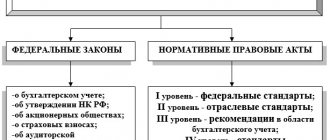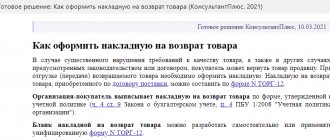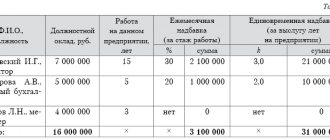Amendments have been made to the Law of December 6, 2011 No. 402-FZ “On Accounting”. The reason for this is Law No. 247-FZ of July 26, 2019. The amendments entered into force on July 26, 2019. The main one is the obligation to comply with the requirements of chief accountants regarding the preparation of accounting documents by all employees of the organization. How to organize document flow in the new conditions? What has already changed in terms of accountants’ responsibility for other people’s mistakes? In the absence of new amendments, how did judicial practice develop regarding holding people accountable for the mistakes of others? You will find answers to these questions in this material.
Source documents
Each fact of economic life must be confirmed by a primary document. It is impossible to take into account documents that document facts of economic life that did not take place (including imaginary and feigned transactions). This is stated in Part 1 of Article 9 of the Law of December 6, 2011 No. 402-FZ.
The forms of primary documents are determined by the head of the organization upon the recommendation of the person entrusted with accounting (Part 4 of Article 9 of the Law of December 6, 2011 No. 402-FZ).
The primary document must contain the following mandatory details:
- Title of the document;
- date of document preparation;
- name of the economic entity (organization) that compiled the document;
- content of the fact of economic life;
- the value of the natural and (or) monetary measurement of a fact of economic life, indicating the units of measurement;
- the names of the positions of the persons who completed the transaction, operation, and those responsible for its execution, or the names of the positions of the persons responsible for the execution of the accomplished event;
- signatures of these persons with transcripts and other information necessary to identify these persons.
Such a list is established by Part 2 of Article 9 of the Law of December 6, 2011 No. 402-FZ.
The primary document must be drawn up when a fact of economic life is committed, and if this is not possible, immediately after its completion (Part 3 of Article 9 of the Law of December 6, 2011 No. 402-FZ).
Primary documents are drawn up on paper and (or) in the form of an electronic document signed with an electronic signature (Part 5 of Article 9 of the Law of December 6, 2011 No. 402-FZ).
Electronic document management and income tax legislation
The organization of tax accounting for the purpose of taxation of profit must be carried out by the organization in accordance with the provisions of the Tax Code of the Russian Federation, Federal Law dated December 6, 2011 N 402-FZ “On Accounting” and Federal Law dated April 6, 2011 N 63-FZ “On Electronic Signature” (see Letter of the Ministry of Finance of Russia dated June 29, 2018 N 03-03-06/1/45251).
Based on paragraph 1 of Art. 252 of the Tax Code of the Russian Federation, the taxpayer reduces the income received by the amount of expenses incurred (except for the expenses specified in Article 270 of the Tax Code of the Russian Federation).
In this case, expenses are recognized as justified and documented expenses (and in cases provided for in Article 265 of the Tax Code of the Russian Federation, losses) incurred by the taxpayer.
Documented expenses mean expenses confirmed by:
— or documents drawn up in accordance with the legislation of the Russian Federation;
- or documents drawn up in accordance with business customs applied in the foreign state in whose territory the corresponding expenses were incurred, and (or) documents indirectly confirming the expenses incurred (including a customs declaration, business trip order, travel documents, report about the work performed in accordance with the contract).
In order to generate tax accounting data, it is necessary to have properly executed supporting documents confirming the expenses incurred.
It should be taken into account that, according to Art. 313 of the Tax Code of the Russian Federation, tax accounting is a system for summarizing information for determining the tax base for income tax based on data from primary documents, grouped in accordance with the procedure provided for by the Tax Code of the Russian Federation.
In accordance with paragraphs 1 and 5 of Art. 9 of the Federal Law of December 6, 2011 N 402-FZ “On Accounting”, each fact of economic life is subject to registration as a primary accounting document. The primary accounting document is drawn up on paper and (or) in the form of an electronic document signed with an electronic signature.
Relations in the field of using electronic signatures when making civil transactions, providing state and municipal services, performing state and municipal functions, and when performing other legally significant actions are regulated by Law No. 63-FZ.
Information signed with an enhanced qualified electronic signature is recognized as an electronic document equivalent to a paper document signed with a handwritten signature (Clause 1 of Article 6 of Law No. 63-FZ).
Also, in paragraph 2. Article 6 of this Law states that information in electronic form, signed with a simple electronic signature or an enhanced unqualified electronic signature, is recognized as an electronic document equivalent to a document on paper, signed with a handwritten signature, in cases established by federal laws adopted in accordance with them by regulatory legal acts or agreement between participants in electronic interaction.
Thus, an organization’s expenses can be taken into account when calculating the tax base for income tax if they are prepared with documents that comply with the requirements of current legislation, provided that such expenses are justified (see Letters of the Ministry of Finance of the Russian Federation dated December 4, 2019 N 03-03-06/1/ 94297, dated August 13, 2021 N 03-03-06/1/60949, dated July 12, 2021 N 03-03-07/48651).
Note that electronic documents can be signed with a simple electronic signature or an enhanced unqualified electronic signature, if this is provided for by the agreement between the participants in the electronic interaction. But in order to write off tax expenses on the basis of a “primary document” signed with a simple or unqualified signature, the agreement with the counterparty must stipulate the procedure for verifying the signature (see Letter of the Ministry of Finance of Russia dated 03/05/2019 N 03-03-07/14313).
Taking into account the above, we can conclude that if the primary accounting document complies with the requirements of Law N 402-FZ, and is also signed with an electronic signature, it can be the basis for generating tax accounting data, as well as confirm the company’s income and expenses for tax purposes. profit.
Standard forms
Unified forms of documents from albums of unified forms approved by the resolutions of the State Statistics Committee of Russia are not mandatory for use. At the same time, the forms established by authorized bodies on the basis of federal laws remain mandatory for use. Thus, the organization is obliged to use standard forms of documents approved by the Government of the Russian Federation, the Bank of Russia (for example, payment orders, expenditure and cash receipt orders) and other authorized bodies in pursuance of federal laws. Such clarifications are contained in the information of the Ministry of Finance of Russia dated December 4, 2012 No. PZ-10/2012, letter of the Federal Tax Service of Russia dated June 23, 2014 No. ED-4-2/11941.
If for any fact of economic life a unified form of the primary document is established by a resolution of the State Statistics Committee of Russia, then the organization has the right, at its own choice:
- or develop the document form yourself;
- or use a unified form.
According to the general rule, the forms of primary documents are determined by the head of the organization upon the recommendation of the person entrusted with accounting (Part 4 of Article 9 of the Law of December 6, 2011 No. 402-FZ). That is, the manager must approve either the form independently developed by the organization, or the fact that the organization uses unified forms.
In any case, the primary document must contain all the mandatory details listed in Part 2 of Article 9 of the Law of December 6, 2011 No. 402-FZ. The information included in this list is identical in composition and content to the details of documents compiled according to forms from albums of unified forms. That is, the current unified forms comply with the requirements of Part 2 of Article 9 of the Law of December 6, 2011 No. 402-FZ.
If necessary, you can add details to unified forms (additional rows, columns, etc.) or exclude them. Approve the corrected unified form by order (instruction) of the manager as the primary document.
Such conclusions follow from the provisions of Article 9 of the Law of December 6, 2011 No. 402-FZ and are confirmed by information from the Ministry of Finance of Russia dated December 4, 2012 No. PZ-10/2012. The correctness of this approach was confirmed by the Federal Tax Service of Russia in a letter dated February 12, 2015 No. GD-4-3/ [email protected] , having sent a letter from the Ministry of Finance of Russia dated February 4, 2015 No. 03-03-10/4547 to lower inspections. This letter from the tax service is posted on the official website of the Federal Tax Service of Russia in the section “Explanations that are mandatory for use.”
An example of how to add additional information to a unified form
At Alpha LLC, repayment of debts to accountable persons sometimes occurs in non-cash form. In order to display this operation in the unified form of the advance report, it was decided to add an additional line to it: “Overexpenditure in the amount of___ was transferred to the employee’s salary card according to the payment order dated “__” ________ 200__. No. ___.” This form was approved by order of the head of the organization.
How to approve forms
Approve the forms of primary documents in the accounting policy (clause 4 of PBU 1/2008).
In this case, standard forms without changes do not need to be attached to the accounting policies. The fact of using unified forms can be reflected in the accounting policies in the following ways:
- write: “The unified forms contained in the albums of unified forms approved by the State Statistics Committee of Russia are used as forms of primary accounting documents, without changes.” In this case, you will need to use uniform forms for each operation for which a form exists;
- prescribe for different accounting objects which unified forms the organization will use, something like this: “...use the unified form _____, approved by the resolution of the State Statistics Committee of Russia dated _____ No. _______.” For example, when using the unified form No. TORG-12, you can make the following entry: “Use the unified form No. TORG-12, approved by Decree of the State Statistics Committee of Russia dated December 25, 1998 No. 132, to register the sale (release) of inventory items to a third party organization.” .
Include samples of independently developed forms approved by the manager in the appendix to the order approving the accounting policy.
Registration
This norm establishes that the written requirements of the chief accountant are mandatory for all employees of the organization:
- on documenting the facts of economic life;
- submission of primary and other documents for accounting.
If there is no chief accountant in the organization, the norm applies to the official who is entrusted with accounting. Or to a person with whom an agreement has been concluded for the provision of accounting services.
Thus, the requirements of the chief accountant became mandatory for all employees of the organization, including the director.
At the same time, if there are disagreements between the head of the organization and the chief accountant regarding accounting, the chief accountant is obliged to take into account the data contained in the disputed primary documents. But provided that the manager has issued a written order to this effect. Well, be solely responsible for the information created as a result of such an order. And the chief accountant who objects to the registration of a particular fact in accounting is exempt from liability (Clause 8 of Article 7 of the Accounting Law).
The list of primary accounting documents that are used in a particular transaction depends on the characteristics of a particular transaction. Here is a standard list of primary documents that companies use in practice.
1. Agreement
A contract as a paper is traditionally not considered a primary document. But it regulates the rights and obligations of the parties to the transaction. Moreover, the Civil Code allows contracts to be concluded orally, and for some types of transactions a written form of contract is not needed at all. For example, a purchase and sale agreement. It is considered concluded from the moment the buyer is issued a cash receipt, sales receipt or other document that confirms the fact of payment. However, concluding a written agreement can protect both the seller and the buyer in case of violations or mutual claims, etc. In addition, on the basis of a written agreement it is easier to prove your case in court.
From August 19, 2021, Federal Law No. 163-FZ of July 18, 2017 is in force. Reducing taxes using schemes and shell companies was officially banned. At the same time, any tax expenses and deductions can be taken into account, but only if two conditions are simultaneously met: the main purpose of the transaction is to make a profit and not to reduce taxes, and the obligation under the transaction was fulfilled by the person specified in the supply agreement. So it is better to conclude an agreement in writing so that, if necessary, you can present it to inspectors.
2. Account
There is no unified invoice form, so each company can develop its own form. The invoice, in addition to the generally accepted data (details of the seller, name of the buyer, number, date of issue) may also contain additional information about the terms of the transaction: terms and procedure for payment and delivery, pickup of goods, notification of prepayment, etc. The buyer who pays the specified amount in the invoice, accepts the terms of the agreement.
3. Payment documents
A payment document can be a payment order, a payment request, a cash and sales receipt, a strict reporting form. Payment orders are used for non-cash payments. The buyer receives a cash receipt, sales receipt or BSO from the seller at the time of payment in cash. Payment documents confirm the fact of payment for goods, works or services.
4. Delivery note
Used to formalize the sale (release) of inventory items to a third-party company, executed in two copies. The first copy remains with the seller (confirms the release of goods to the third party), and the second copy is transferred to the buyer (used by him to capitalize the received values). The invoice data must not differ from the data indicated on the invoice.
5. Acceptance certificate for work performed (services provided)
The act confirms the fact, cost, timing of work (provision of services). It is necessary to confirm compliance of the work performed with the terms of the contract.
The easiest way to confirm that the services under the contract were actually provided is a bilateral certificate of provision of services. This confirmation is required in order to receive payment. And the performer must be prepared to be able to prove this.
So the judges, taking the side of the contractor, who cannot get a signature from the customer for the act and, accordingly, money, told how else, besides the act signed by both parties, can be used to confirm the fact of the provision of services.
The dispute considered by the court concerned payment for security services. You can prove their provision:
- a unilateral act with evidence that it was timely sent to the customer at the legal address;
- an agreement for the provision of services, which contains a clause stating that in the event of failure to receive a written claim from the customer under the act, the services specified in it are considered to be provided in full;
- employment contracts that specify the place of provision of services;
- duty schedules for security guards at the site;
- video surveillance system materials.
As you can see, in addition to formal documents, an act and an agreement on the provision of services, it is quite possible to confirm their actual provision. It should follow from the evidence presented that the services under the contract actually took place. It is also useful to be prepared for possible disputes and carefully draw up the contractual basis (Resolution of the Arbitration Court of the Volga-Vyatka District of June 19, 2021 No. F01-10160/2020 in case No. A43-22315/2019).
What are the requirements for primary accounting documents that are accepted to confirm expenses for tax purposes, read in the “Income Tax” section, subsection “Expenses that reduce profit”, situation “Justification of expenses”.
Registers
The data contained in the primary documents is reflected in the accounting registers. Accounting registers are lists of transactions in chronological order, grouped by accounting accounts (for example, statements, reports in tabular form).
The register forms are approved by the head of the organization. The required details of the accounting register are:
- register name;
- name of the organization (economic entity) that compiled the register;
- the start and end dates of maintaining the register and (or) the period for which it was compiled;
- chronological and (or) systematic grouping of accounting objects;
- unit of measurement;
- names of positions of persons responsible for maintaining the register and their signatures with a transcript.
Registers are compiled on paper and (or) in the form of an electronic document signed with an electronic signature.
When making corrections to the registers, you must indicate the date of the correction, as well as the signatures of the persons responsible for maintaining this register (with a transcript).
When registering accounting objects in registers, the following are not allowed:
– omissions or withdrawals;
– reflection of imaginary and feigned accounting objects.
Such rules are defined by Article 10 of the Law of December 6, 2011 No. 402-FZ.
The employee responsible for preparing the primary document must ensure its timely transfer for inclusion in the accounting registers. In this case, this employee is responsible for the accuracy of the data recorded in the primary document. This is stated in Part 3 of Article 9 of the Law of December 6, 2011 No. 402-FZ.
Electronic signature and accounting reporting
Previously, financial statements were considered prepared only after they were signed by the manager on paper.
According to the new rules, the manager can sign the statements with an electronic signature and it will be considered drawn up on this date.
So, according to clause 7.1. Art. 13 of Law N 402-FZ, accounting (financial) statements are prepared on paper and (or) in the form of an electronic document signed with an electronic signature.
If the legislation of the Russian Federation or an agreement provides for the submission of accounting (financial) statements to another person or to a government body on paper, the economic entity is obliged, at the request of another person or government body, at its own expense, to prepare copies of the accounting (financial) statements on paper, compiled in the form of an electronic document.
Entrepreneur on OSNO
Documentation of business transactions carried out by an individual entrepreneur applying the general taxation system is regulated by the Procedure approved by order of the Ministry of Finance of Russia No. 86n dated August 13, 2002 and the Ministry of Taxes of Russia No. BG-3-04/430.
The requirements for primary accounting documents are contained in paragraph 9 of this procedure. They almost completely coincide with the requirements for primary accounting documents used by organizations. The only addition is that individual entrepreneurs must attach to the primary document that documents the sale of goods or their purchase, a primary document confirming payment for this product.
Separate division
Situation: can a separate division reflect business transactions on the basis of primary documents issued on behalf of the head office of the organization? A separate division is allocated to a separate balance sheet and conducts accounting independently.
Yes maybe.
At the same time, the accounting policy must reflect the condition that all primary documents are drawn up on behalf of the head office.
The organization establishes the methods of accounting independently and prescribes them in the accounting policy for accounting purposes (Article 8 of the Law of December 6, 2011 No. 402-FZ). The provisions specified in the accounting policy apply to all separate divisions of the organization (clause 9 of PBU 1/2008). Therefore, if the organization’s accounting policy states that all primary documents are drawn up on behalf of the head office, then a separate division has the right to conduct accounting on the basis of such registers.
In addition, one of the mandatory details of any primary document is the name of the economic entity that compiled the document (subclause 3, part 2, article 9 of the Law of December 6, 2011 No. 402-FZ). Economic entities are considered, in particular, commercial and non-profit organizations (subparagraph 1, part 1, article 2 of the Law of December 6, 2011 No. 402-FZ). An organization is recognized as a legal entity registered in accordance with the legislation of the Russian Federation (Clause 1, Article 48, Article 51 of the Civil Code of the Russian Federation). A separate division is not an independent legal entity; it is part of it (Article 55 of the Civil Code of the Russian Federation). Consequently, a separate division, conducting accounting independently on the basis of documents drawn up on behalf of the head office of the organization, does not violate accounting legislation.
Accounting information
Situation: in what cases is it necessary to prepare an accounting certificate?
An accounting certificate must be prepared in any cases where an accountant needs to justify transactions or calculations. For example:
- when submitting updated declarations to justify the calculations reflected in them (letter of the Federal Tax Service of Russia dated December 14, 2006 No. 02-6-10/233);
- to confirm the amounts reflected in accounting, for example, when calculating dividends;
- to justify reversal entries, etc.
This primary document must contain the mandatory details listed in Part 2 of Article 9 of the Law of December 6, 2011 No. 402-FZ.
Signatures in documents
Draw up all primary documents when performing a transaction (transaction, event). And if this is not possible - immediately after the end of the operation (transaction, event). Responsibility for registration lies with the employees who signed the primary document.
Such rules are established by Article 9 of the Law of December 6, 2011 No. 402-FZ.
The list of employees who have the right to sign primary documents can be approved by the head of the organization by his order.
At the same time, the procedure for signing documents used to formalize transactions with funds is regulated, in particular, by Bank of Russia Directive No. 3210-U dated March 11, 2014 and Bank of Russia Regulation No. 383-P dated June 19, 2012.
In any case, the primary document must be signed in such a way that it is possible to identify those who signed it (the persons responsible for processing the transaction). That is, the signatures in the document must be decrypted.
This follows from Part 2 of Article 9 of the Law of December 6, 2011 No. 402-FZ and is confirmed by the letter of the Ministry of Finance of Russia dated September 10, 2013 No. 07-01-06/37273.
Let’s say an organization that is not a small (medium) enterprise has entered into an agreement with a third-party contractor for the provision of accounting services. Who should sign the primary documents for the chief accountant in this case?
The manager himself must appoint a list of people who have the right to sign primary accounting documents (clause 14 of the Regulations approved by order of the Ministry of Finance of Russia dated July 29, 1998 No. 34n, information of the Ministry of Finance of Russia No. PZ-10/2012). These can be employees of the organization (cashier, manager, etc.), as well as representatives of a third-party organization that does accounting.
The right to sign bank documents can be transferred to full-time employees, as well as to persons providing accounting services (clause 7.5 of Bank of Russia Instruction No. 153-I dated May 30, 2014). Thus, in addition to the head of the organization, bank documents can be signed by an employee of the organization or the head of a third-party organization that keeps records.
At the same time, the head of the organization himself cannot sign for the chief accountant. The fact is that, since the organization is not a small (medium) enterprise, the manager cannot take over the accounting. This conclusion follows from Part 3 of Article 7 of the Law of December 6, 2011 No. 402-FZ.
Unlike organizations, an individual entrepreneur cannot transfer the right to sign primary documents to third parties. This is directly indicated in paragraph 10 of the Procedure, approved by order of August 13, 2002 of the Ministry of Finance of Russia No. 86n and the Ministry of Taxes of Russia No. BG-3-04/430.
Situation: can the chief accountant sign contracts if he is the founder of the organization?
Yes, it can, but only if he has a power of attorney for the right to sign, issued by the head of the organization (Clause 4 of Article 185.1 of the Civil Code of the Russian Federation).
In other cases, the right to sign contracts on behalf of the organization belongs to the head (unless otherwise provided by the organization’s charter) (Clause 1, Article 53 of the Civil Code of the Russian Federation).
Situation: what color of ink should be used to sign primary documents, as well as invoices?
As a general rule, any color, but there are special requirements for bank documents.
The legislation does not impose requirements on the color of ink that must be used to sign primary documents, as well as invoices. Clause 2.8 of the Regulations approved by the USSR Ministry of Finance dated July 29, 1983 No. 105 (applied to the extent that does not contradict current legislation) states that entries in primary documents must be made in ink, crayon or ballpoint pen paste. Do not use a pencil for writing.
An exception is provided only for bank documents. Clause 1.7.2 of the Rules approved by Bank of Russia Regulation No. 385-P dated July 16, 2012 states that each document submitted to a credit institution on paper must have the signatures of authorized officials and a seal imprint and correspond to the declared samples. In this case, signatures on all documents must be made with a pen with black, blue or purple ink.
Tip: Sign source documents as well as invoices using traditional ink colors (black, blue or purple).
The fact is that when copying primary documents and invoices filled out using red or green ink, the data specified in this way may not appear on the copies of the documents. This may lead to negative consequences when submitting copies of documents for a tax audit (see, for example, Resolution of the Federal Antimonopoly Service of the East Siberian District dated February 14, 2006 No. A19-13900/05-43-F02-290/06-S1).
Problems with document flow for remote employees working remotely
In the context of the new coronavirus pandemic, a widely used measure to combat the spread of infection is the transfer of employees of organizations to remote work. This regime involves a change in approaches to working with documents, including a change in the order of registration of facts of economic life in primary accounting documents.
The need to change this procedure affects, at a minimum, that part of the organization’s document flow that has not been completely converted into electronic form.
In particular, problems arise with signing paper documents by several persons working remotely and exchanging documents between different persons. When personal contact between individuals is limited, it becomes problematic to draw up a document on paper, sign it on paper, send it to the counterparty, receive it by mail/courier, send it by mail/courier, return the paper original signed on both sides, and transfer it to the accounting department from both parties.
Legally significant electronic document management could solve this problem, but for this it must be implemented by all counterparties, and also be used in internal documents of organizations, including those signed by commissions (write-off acts, advance reports, etc.).
It is necessary to analyze the requirements of legislation and regulatory legal acts on accounting regarding the registration of facts of economic life with primary accounting documents and determine the optimal approaches to meeting these requirements for paper documents in remote working conditions.
Electronic documents
Primary documents can be prepared both in paper and electronic form (Part 5 of Article 9 of the Law of December 6, 2011 No. 402-FZ). The last option is possible if an electronic signature is placed on the documents (Article 6 of the Law of April 6, 2011 No. 63-FZ).
The requirements for an electronic signature are provided for by the Law of April 6, 2011 No. 63-FZ.
There are the following types of electronic signature: simple unqualified, enhanced unqualified and enhanced qualified (Article 5 of the Law of April 6, 2011 No. 63-FZ). The legal force of the document will depend on what signature the organization uses.
Thus, primary documents certified with a simple or enhanced non-qualified electronic signature cannot be accepted for accounting and tax purposes. They are not recognized as equivalent to paper documents certified by a handwritten signature.
On the contrary, documents certified by an enhanced qualified electronic signature are equated to those signed personally and are accepted for accounting and tax purposes.
Similar conclusions follow from paragraphs 1 and 2 of Article 6 of the Law of April 6, 2011 No. 63-FZ and confirmed by letters of the Ministry of Finance of Russia dated April 12, 2013 No. 03-03-07/12250, dated December 25, 2012 No. 03- 03-06/2/139, dated May 28, 2012 No. 03-03-06/2/67, dated July 7, 2011 No. 03-03-06/1/409.
The format for submitting a document on the transfer of goods during trade operations in electronic form was approved by Order of the Federal Tax Service of Russia dated November 30, 2015 No. ММВ-7-10/551. The format for presenting the document on the transfer of work results (document on the provision of services) in electronic form was approved by Order of the Federal Tax Service of Russia dated November 30, 2015 No. ММВ-7-10/552. These formats are relevant both in business activities and when submitting documents at the request of the inspection in electronic form.
The Federal Tax Service of Russia does not plan to develop formats for standard forms.
If the legislation of Russia or an agreement provides for the submission of a primary document to a counterparty or to a government agency (for example, a tax office) on paper, the organization is obliged to make a paper copy of the electronic document at its own expense (Part 6, Article 9 of Law of December 6, 2011 No. 402 -FZ).
What if an organization draws up documents not according to the format approved by the Federal Tax Service of Russia? Then submit the forms to the inspectors on paper - certify the copies with a note that the documents are signed with an electronic signature.
Similar clarifications are given in the letter of the Federal Tax Service of Russia dated November 10, 2015 No. ED-4-15/19671.
For details on how to submit documents to tax inspectors, see:
- How to submit documents at the request of inspectors during a desk tax audit;
- How to submit documents at the request of inspectors during an on-site tax audit.
If an organization decides to process primary documents in electronic form, this method of maintaining documentation must be reflected in the accounting policy. In particular, the accounting policy needs to record:
- list of documents participating in electronic document flow;
- list of employees authorized to sign electronic documents;
- method of electronic exchange of documents (with or without the involvement of an electronic document management operator);
- procedure for storing electronic documents;
- method of submitting documents at the request of the tax office (electronically or on paper).
This follows from Article 8 of the Law of December 6, 2011 No. 402-FZ.
But the formats of electronic documents that the organization uses do not need to be reflected in the accounting policies. This was confirmed by the Federal Tax Service of Russia in a letter dated November 10, 2015 No. ED-4-15/19671. Although this letter deals with accounting policies for tax purposes, the conclusion of the Federal Tax Service of Russia is also relevant for accounting policies for accounting purposes.
Electronic document management
Electronic document management is a way of exchanging and working with documents, the originals of which are generated in electronic form.
The peculiarities of electronic document management are that electronic documents are signed with an electronic signature.
Such a document signed with an electronic signature is equal in value to a paper document, subject to certain conditions being met (Article 6 of Federal Law No. 63-FZ of April 6, 2011 “On Electronic Signatures” (hereinafter referred to as Law No. 63-FZ)).
Printing on documents
The seal is not listed among the mandatory details of the primary documents listed in Part 2 of Article 9 of the Law of December 6, 2011 No. 402-FZ.
Therefore, put a stamp on the document:
- if the organization, at its own choice, uses an independently developed form approved by the head, which includes a seal;
- if the organization, of its own choice, uses a unified form contained in the album of unified forms, which includes a seal. At the same time, the manager approved that the form is used without changes (or the changes do not affect the seal);
- when applying standard mandatory forms established by authorized bodies (the Government of the Russian Federation, the Bank of Russia, etc.) on the basis of federal laws, if the standard forms require a seal.
Such conclusions follow from the provisions of Article 9 of the Law of December 6, 2011 No. 402-FZ.
The list of documents on which the organization’s seal is required (optional) is given in the table.
In agreements that an organization usually concludes (purchase and sale, provision of services, etc.), a seal also does not need to be affixed. A seal must be affixed only if this is expressly provided for in the contract (Clause 1, Article 160 of the Civil Code of the Russian Federation).
One more thing. From April 7, 2015, LLCs and joint stock companies may not have seals at all. This is provided for in Articles 2 and 6 of the Law of April 6, 2015 No. 82-FZ.
Documents in a foreign language
Documents written in a foreign language must have a line-by-line translation into Russian. This is necessary both for accounting and tax purposes (clause 9 of the Regulations on Accounting and Reporting, Article 313 of the Tax Code of the Russian Federation, letter of the Ministry of Finance of Russia dated February 28, 2012 No. 03-03-06/1/106).
There is no need to add anything to the documents themselves. Attach separate translations signed by the translators. A document can be translated into Russian by either a professional translator or an employee of an organization who speaks a foreign language (letters of the Ministry of Finance of Russia dated April 20, 2012 No. 03-03-06/1/202, dated March 26, 2010 No. 03-08- 05/1).
However, the organization may retain some words in a foreign language if they are a registered trademark, for example, the name of the airline on an airline ticket (Article 6 of the Convention for the Protection of Industrial Property of March 20, 1883) or are not essential for confirming the expenses incurred, for example, in an air ticket in a foreign language - the terms of application of the fare, rules of air transportation, rules for the transportation of baggage and other similar information (letters of the Ministry of Finance of Russia dated March 24, 2010 No. 03-03-07/6, dated September 14, 2009 No. 03- 03-05/170).
If documents in a foreign language are compiled according to a standard form (identical in the number of columns, their names, decoding of works, etc. and differ only in the amount), then with regard to their constant indicators, a one-time translation into Russian is sufficient. Subsequently, only the changing indicators of this primary document need to be translated. Such clarifications are contained in the letter of the Ministry of Finance of Russia dated November 3, 2009 No. 03-03-06/1/725.
Electronic signature and VAT legislation
Regarding the signing of electronic invoices (clause 6 of Article 169 of the Tax Code of the Russian Federation), as well as when carrying out electronic interaction with tax authorities, it is necessary to use only an enhanced qualified electronic signature.
The procedure for issuing and receiving invoices in electronic form via telecommunication channels using an enhanced qualified electronic signature was approved by Order of the Ministry of Finance of Russia dated November 10, 2015 N 174n “On approval of the Procedure for issuing and receiving invoices in electronic form via telecommunication channels using enhanced qualified electronic signature."
Thus, tax legislation imposes a requirement to use a qualified electronic signature for electronic invoices (see Letter of the Ministry of Finance of the Russian Federation dated September 12, 2021 N 03-03-06/1/58456).
Error correction
Corrections in primary documents are allowed (Part 7, Article 9 of the Law of December 6, 2011 No. 402-FZ).
The procedure for correcting errors in primary documents should be established in the accounting policy for accounting purposes or in an appendix to it. The organization independently develops ways to make corrections to the primary document (both on paper and in the form of an electronic document). Focus on the requirements of the Law of December 6, 2011 No. 402-FZ, accounting regulations and take into account the peculiarities of document flow. When developing such methods, you can focus on current regulations governing similar issues (for example, Rules for filling out invoices, approved by Decree of the Government of the Russian Federation of December 26, 2011 No. 1137). This was stated in the letter of the Ministry of Finance of Russia dated January 22, 2021 No. 07-01-09/2235.
Correct errors in primary documents as follows: cross out the incorrect text and write the corrected text above the crossed out text. Crossing out is done with one line so that the correction can be read. Certify corrections in documents with the signatures of the persons who compiled the document (indicating their last names and initials or other details necessary to identify these persons), and indicate the date the correction was made.
You cannot make corrections to cash and bank documents. Such rules are established by paragraph 7 of Article 9 of the Law of December 6, 2011 No. 402-FZ, section 4 of the Regulations approved by the Ministry of Finance of the USSR on July 29, 1983 No. 105, and paragraph 4.7 of the Bank of Russia directive of March 11, 2014 No. 3210-U .
An error in the accounting register can be corrected on the basis of an accounting certificate. This document must provide a rationale for the correction.
Corrections not authorized by the persons responsible for maintaining the relevant register are not allowed in accounting registers (Part 8, Article 10 of Law No. 402-FZ of December 6, 2011). If the correction in the register is authorized by the responsible persons, then certify it with the signatures of these persons (indicating their surnames and initials or other details necessary to identify these persons), and indicate the date the correction was made. Such rules are established by paragraph 8 of Article 10 of the Law of December 6, 2011 No. 402-FZ.
Internal control
The organization is obliged to organize and carry out internal control of the facts of economic life. And if its reporting is subject to mandatory audit, then it is obliged to maintain internal control over accounting and reporting (except for cases where the manager has assumed the responsibility for accounting). Such requirements are established by Article 19 of the Law of December 6, 2011 No. 402-FZ.
In addition, one of the tasks of the chief accountant is to organize and control the creation (reception), processing and storage of documents (clause 6.6 of the Regulations approved by the USSR Ministry of Finance on July 29, 1983 No. 105 (valid to the extent that does not contradict the law)). The following tools can be used to perform this task:
- document flow schedule;
- nomenclature of cases.
The procedure for generating and processing documents must be fixed in the document flow schedule (clause 5.1 of the Regulations approved by the USSR Ministry of Finance on July 29, 1983 No. 105). The development of the schedule is organized by the chief accountant. The schedule is approved by order of the head of the organization (clause 5.2 of the Regulations approved by the USSR Ministry of Finance on July 29, 1983 No. 105).
The document flow schedule should describe:
- stages of creating (receiving), checking and transferring a document for storage;
- timing of each stage;
- a list of employees performing business operations and preparing documents;
- list of employees checking documents;
- relationship between responsible persons.
The schedule can be drawn up in the form of a diagram or a list of works indicating the operations and relationships of the performers. An approximate form of this document is given in the appendix to the Regulations approved by the USSR Ministry of Finance on July 29, 1983 No. 105. However, you can develop your own schedule structure. Such rules are established by paragraph 5.4 of the Regulations approved by the USSR Ministry of Finance on July 29, 1983 No. 105.
An example of a document flow schedule in tabular form
The chief accountant of Alpha LLC has developed a document flow schedule in tabular form (see, for example, the part of the document flow schedule dedicated to bank documents).
An example of a document flow schedule in the form of a diagram
Alpha LLC has decided to continue issuing travel certificates for employees going on business trips. The chief accountant of Alpha has developed a document flow schedule in the form of a diagram (see, for example, the scheme for processing a travel certificate).
In organizations with a small document flow, everything can be reduced to drawing up separate memos for employees. The employee should describe in detail what documents he must fill out so that there are no claims against him from the accounting department. For example, an employee goes to pick up paid goods from a supplier. The memo should state what documents he must bring, as well as the period within which they must be submitted to the accounting department. You can also attach samples of the required documents to the memo.
An example of a memo to the contractor on the procedure for completing documents
Document flow at Alpha LLC is organized by drawing up separate memos for employees (see, for example, the memo for a posted employee).
Control over the execution of the document flow schedule is assigned to the chief accountant (clause 5.7 of the Regulations approved by the USSR Ministry of Finance on July 29, 1983 No. 105). Employees of the organization must be familiar with this document or an extract from it. The chief accountant's requirements for document preparation are mandatory for all employees of the organization. For failure to comply with the requirements of the chief accountant, disciplinary action may be taken against employees. Some organizations prescribe compliance with paperwork requirements as one of the bonus conditions.
After processing the document, it is necessary to ensure its safety and subsequent transfer to the archive.
One way to organize the storage of documents is to compile a list of cases. It contains information about which documents should be kept in which department and for how long they should be stored. Form the nomenclature of affairs in the accounting department similarly to the nomenclature of affairs in the personnel department.
Responsible person
The main responsible person for organizing document flow in accounting is the organization's accountant. The list of his responsibilities includes the formation of a list of process rules and data processing techniques; they are implemented in the form of a schedule.
Establishing a document flow procedure in accounting is carried out as follows. First of all, they formulate regulations on the accounting service. Then they draw up job descriptions for employees whose activities are related to documentation and document flow in accounting. After this, they proceed to drawing up the appropriate schedule. The penultimate stage is the creation of a method for processing information in accounting at an enterprise. And last but not least, they develop a nomenclature of cases and a procedure for storing documentation.
Responsibility for the absence of primary documents
Attention: the absence (failure to submit) of primary documents is an offense (Article 106 of the Tax Code of the Russian Federation, Article 2.1 of the Code of Administrative Offenses of the Russian Federation), for which tax and administrative liability is provided.
The absence of primary documents, invoices, as well as accounting and tax registers is recognized as a gross violation of the rules for keeping records of income and expenses. Responsibility for it is provided for in Article 120 of the Tax Code of the Russian Federation.
If such a violation was committed during one tax period, the inspectorate has the right to fine the organization in the amount of 10,000 rubles. If a violation is detected in different tax periods, the fine will increase to RUB 30,000.
A violation that led to an understatement of the tax base will entail a fine of 20 percent of the amount of each unpaid tax, but not less than RUB 40,000.
In addition, at the request of the tax inspectorate, the court may impose administrative liability on officials of the organization (for example, its head) in the form of a fine in the amount of:
- from 300 to 500 rub. for failure to submit primary documents necessary for tax control (part 1 of article 23.1, part 1 of article 15.6 of the Code of Administrative Offenses of the Russian Federation);
- from 2000 to 3000 rub. for failure to comply with the procedure and terms of storage of primary documents (part 1 of article 23.1, article 15.11 of the Code of Administrative Offenses of the Russian Federation).
In each specific case, the perpetrator of the offense is identified individually. In this case, the courts proceed from the fact that the manager is responsible for organizing accounting, and the chief accountant is responsible for its correct maintenance and timely preparation of reports (clause 24 of the resolution of the Plenum of the Supreme Court of the Russian Federation of October 24, 2006 No. 18). Therefore, the subject of such an offense is usually recognized as the chief accountant (an accountant with the rights of the chief). The head of an organization may be found guilty of:
- if the organization did not have a chief accountant at all (resolution of the Supreme Court of the Russian Federation dated June 9, 2005 No. 77-ad06-2);
- if accounting and tax calculation were transferred to a specialized organization (clause 26 of the resolution of the Plenum of the Supreme Court of the Russian Federation of October 24, 2006 No. 18);
- if the reason for the violation was a written order from the manager, with which the chief accountant did not agree (clause 25 of the resolution of the Plenum of the Supreme Court of the Russian Federation of October 24, 2006 No. 18).
Primary documents are lost
Situation: what to do if the primary documents are lost?
If documents confirming recorded transactions are lost, the organization must take action to investigate the causes and restore the loss. To do this, the employee who discovered the loss must write a memo, on the basis of which an order is issued from the manager to appoint a commission to investigate the loss. Document the results of the commission’s work in an act.
If during the work of the commission the tax inspectorate requests documents that were lost, the organization will be able to ask to increase the deadline for submitting documents (clause 3 of article 93 of the Tax Code of the Russian Federation). In this case, the order to create a commission will be a documentary substantiation of such a request.
If, based on the results of the commission’s work, the documents are not discovered (restored), the organization will not be able to confirm the accounting and tax accounting data. In addition, the organization may face liability for the lack of documents.








